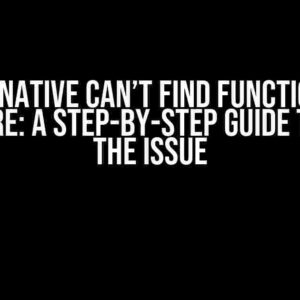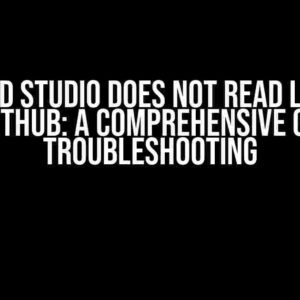Are you tired of banging your head against the wall because Vue’s this.$emits suddenly stops working in the middle of a function call? You’re not alone! This frustrating issue has plagued many a developer, but fear not, dear reader, for we’re about to dive into the whys and hows of fixing this pesky problem.
The Problem: Vue this.$emits Stops Working Mid-Function
Imagine you’re working on a Vue component, and you’ve got a function that’s supposed to emit an event to its parent component. You’ve written the code, and it looks something like this:
<template>
<button @click="handleButtonClick">Click me!</button>
</template>
<script>
export default {
methods: {
handleButtonClick() {
// Some code here
this.$emit('buttonClicked', 'Hello, world!');
// More code here
}
}
}
</script>
Everything looks good, and you’re feeling confident that your code will work as expected. But, when you click the button, the event is not emitted. You’ve tried console logging, debugging, and even sacrificing a few keyboard keys to the coding gods, but nothing seems to work.
What’s Going On?
The reason why Vue’s this.$emits stops working mid-function is often due to one of the following reasons:
- Component Lifecycle**: Vue’s component lifecycle can sometimes interfere with the emission of events. If the component is being destroyed or recreated during the function call, this.$emits might stop working.
- Async Code**: If you’re using async code within your function, it might cause the this.$emits to fail. This is because async code can create a new scope, which can lead to this.$emits being undefined or null.
- Scoping Issues**: Sometimes, the this context can get lost within a function, especially when using arrow functions or callbacks. This can cause this.$emits to point to the wrong scope or be undefined.
Solutions to the Rescue!
Now that we’ve identified the possible causes, let’s dive into the solutions:
1. Use a Separate Emitter Function
Create a separate function that’s responsible for emitting the event. This ensures that the emission is decoupled from the rest of the function and reduces the chances of interference from the component lifecycle or async code.
<script>
export default {
methods: {
handleButtonClick() {
// Some code here
this.emitButtonClicked();
// More code here
},
emitButtonClicked() {
this.$emit('buttonClicked', 'Hello, world!');
}
}
}
</script>
2. Use an Immediately Invoked Function Expression (IIFE)
Create an IIFE to ensure that the emission occurs within the correct scope. This is especially useful when working with async code or callbacks.
<script>
export default {
methods: {
handleButtonClick() {
(function.emitButtonClicked() {
this.$emit('buttonClicked', 'Hello, world!');
}.bind(this))();
}
}
}
</script>
3. Use an Arrow Function with bind()
When using arrow functions, you can use the bind() method to ensure that the this context is preserved.
<script>
export default {
methods: {
handleButtonClick() {
const emitButtonClicked = () => {
this.$emit('buttonClicked', 'Hello, world!');
}.bind(this);
emitButtonClicked();
}
}
}
</script>
4. Avoid Using Async Code Within the Function
If possible, try to avoid using async code within the function that’s emitting the event. Instead, use async code outside the function or use a promise chains to handle the asynchronous operations.
<script>
export default {
methods: {
handleButtonClick() {
// Async code here
asyncFunction().then(() => {
this.$emit('buttonClicked', 'Hello, world!');
});
}
}
}
</script>
5. Use the Vue Devtools to Debug
Finally, if all else fails, use the Vue Devtools to debug your application. The Devtools can help you identify the root cause of the issue and pinpoint where the this.$emits is failing.
| Solution | Description |
|---|---|
| Separate Emitter Function | Decouples emission from the rest of the function |
| IIFE | Ensures emission occurs within the correct scope |
| Arrow Function with bind() | Preserves the this context within an arrow function |
| Avoid Async Code | Ensures emission is not interrupted by async code |
| Vue Devtools | Helps debug and identify the root cause of the issue |
Conclusion
Vue’s this.$emits stopping working mid-function can be frustrating, but by understanding the possible causes and applying the solutions outlined above, you’ll be well on your way to fixing the issue and getting your application working as expected. Remember to keep your code clean, decoupled, and debugged, and you’ll be emitting events like a pro in no time!
So, the next time you encounter this issue, don’t pull your hair out – just refer back to this article and try out the solutions. Happy coding, and may the Vue be with you!
- Remember to check the Vue documentation for the latest information on event emission and component lifecycle.
- Explore other Vue-related articles and tutorials to deepen your understanding of the framework.
- Join online communities and forums to connect with other developers and get help with any Vue-related issues.
Further Reading
Happy coding, and see you in the next article!
Frequently Asked Question
Are you tired of dealing with the mystery of Vue’s this.$emit suddenly stopping working in the middle of a function call? Well, you’re not alone! Here are some answers to the most common questions about this frustrating issue:
Q1: What are some common reasons why this.$emit stops working?
Some common reasons include incorrect component registration, mismatched event names, and accidentally overriding the $emit method. Also, make sure you’re not using arrow functions as lifecycle hooks, as they can cause issues with the `this` context.
Q2: How do I debug this issue when it happens?
When debugging, try adding a console log before and after the `this.$emit` call to see if it’s being reached. Check the Vue devtools to ensure the component is properly registered and the event is being triggered. You can also use Vue’s built-in `Vue.config.errorHandler` to catch and log errors.
Q3: Can I use async/await with this.$emit?
Yes, you can use async/await with `this.$emit`, but be careful not to accidentally return a promise that resolves before the `this.$emit` call is executed. Make sure to use `async/await` correctly to avoid unexpected behavior.
Q4: Are there any known issues with this.$emit in Vue 3?
In Vue 3, there’s a known issue with `this.$emit` not working as expected when using the `setup` function. This is because `setup` has its own `this` context. To fix this, use the `emit` function provided by the `setup` context instead of `this.$emit`.
Q5: What’s the best way to refactor my code to avoid this issue?
To avoid this issue, consider refactoring your code to use a more functional programming approach. Break down your logic into smaller, reusable functions that don’t rely on `this.$emit`. This will make your code more maintainable and easier to debug. Additionally, consider using a state management library like Vuex to handle global state changes.





